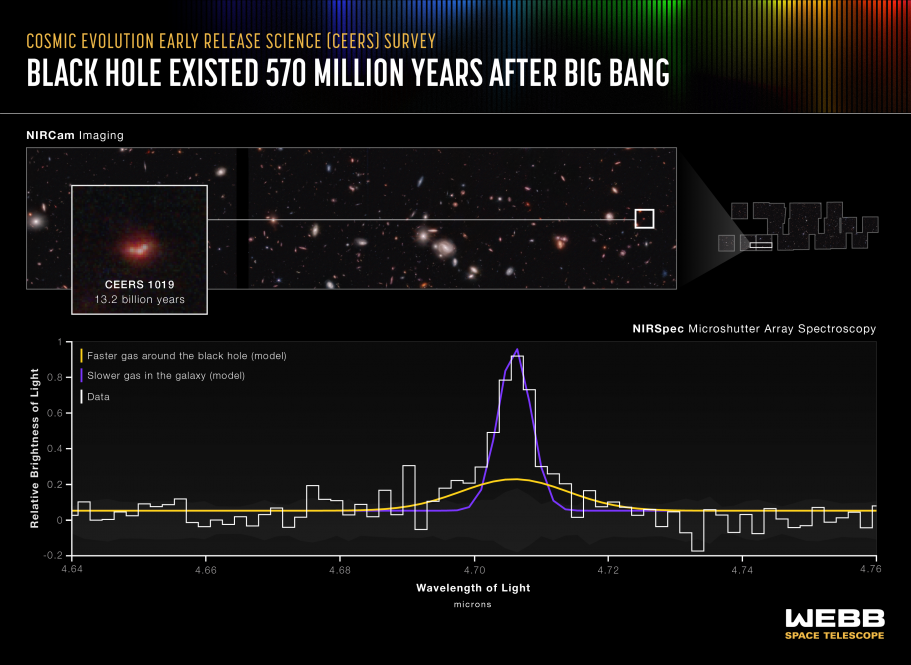Since its launch just over a year and a half ago, the James Webb Space Telescope (JWST) has enabled researchers to peer deeper into space, with greater clarity than ever before. Now, astronomers from the Cosmic Evolution Early Release Science (CEERS) Survey led by Steven Finkelstein of the University of Texas at Austin, including UConn Department of Physics associate professor Jonathan Trump, have found supermassive black holes in several of the earliest, most distant galaxies. The team has released these findings in several initial papers in The Astrophysical Journal Letters.
The galaxy named CEERS 1019 developed around 570 million years after the Big Bang and contains a surprisingly massive black hole. The pre-print detailing this discovery can be found here. Totaling around nine million times more massive than our galaxy’s sun, CEERS 1019’s black hole is much more massive than expected for living in a very young galaxy in the early universe. What’s more, the black hole is still actively accreting – or accumulating – surrounding matter, likely on its way to growing into one of the largest black holes observed in the universe today, one billion times larger than our sun. Trump and the CEERS team spotted the black hole through the high-velocity gas associated with the accretion of matter outside the black hole’s event horizon.
“We know that all galaxies today – including our own Milky Way – have a supermassive black hole in their center,” says Trump. “But there’s an outstanding mystery of how these supermassive black holes first form in the early Universe. I think of it as a ‘chicken-or-egg’ problem of which comes first, the black hole or the galaxy.”
CEERS 1019’s black hole is difficult to explain, Trump explains:
“These new black hole discoveries are surprising because the black holes are bigger than expected for the early universe. There’s a fundamental limit to how quickly black holes can accrete matter before their associated energy output blows the material back out. These black holes probably needed to form via a somewhat exotic ‘direct-collapse’ scenario in which gas in the early universe collapses straight down into a black hole rather than forming stars.”
The JWST is supplying the researchers with massive amounts of data to comb through, and they quickly identified two additional supermassive black holes in young galaxies in the distant and early universe, detailed in another pre-print that can be found here.
With these three “little monsters” practically leaping out of the early JWST observations, the researchers suspect there are many more out there to find.
“Until now, research about objects in the early universe was largely theoretical,” Finkelstein says. “With Webb, not only can we see black holes and galaxies at extreme distances, we can now start to accurately measure them. That’s the tremendous power of this telescope.”
The CEERS Survey analyzes data collected by JWST’s imaging equipment including, the Near Infrared Camera (NIRCam), Mid-Infrared Instrument (MIRI), and NIRSpec spectroscopy. These infrared spectra and images reveal these exciting insights into our universe’s history. Fortunately, the CEERS collaboration is extensive, with many astronomers working together to analyze the data.
“Looking at this distant object with this telescope is a lot like looking at data from black holes that exist in galaxies near our own,” says Rebecca Larson of the University of Texas at Austin, who led this discovery. “There are so many spectral lines to analyze.” Not only could the team untangle which emissions in the spectrum are from the black hole and which are from its host galaxy, but they could also use the velocity of the gas to pinpoint the mass of the black hole and determine its galaxy’s star-formation rate.
Using the spectral data, the team were able to pinpoint the origins of the emission but also measure how much gas the black holes are emitting to determine aspects of the galaxy, such as its star-formation rate. For CEERS 1019, the galaxy is ingesting vast quantities of gas and producing new stars at a high rate, and visually, CEERS 1019 appears as three bright clumps, not a single circular disk.
Still in the early stages of harnessing the capabilities of JWST, the CEERS team is eager to see what other secrets of the universe’s history the data will reveal.
“I had no idea we’d find so many massive black holes in the early universe – it’s a wonderful surprise for me because understanding how black holes grow and form is the focus of my research program at UConn,” says Trump. “JWST has been observing for only about a year, and so this discovery really is just the tip of the iceberg of what we can expect to learn from the new telescope. I can’t wait to see what we learn next from our new view of the cosmic dawn!”
This was adapted from a news release by the Space Telescope Science Institute.



